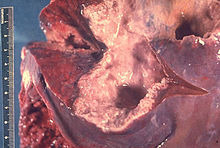Amoebic liver abscess
| Amoebic hepatic abscess | |
|---|---|
 | |
| Gross pathology of liver containing amoebic abscess | |
| Specialty | Infectious diseases |
A amoebic liver abscess is a type of
Presentation
Approximately 90% of patients with E histolytica are asymptomatic.[2] The two most common manifestations of E histolytica include colitis (bloody stool with mucus, abdominal pain, and/or diarrhea), and discovery of a liver abscess on imaging.[2] Liver abscesses commonly present as right upper quadrant abdominal pain and fever, with worsening features associated with abscess rupture.[2]

Symptoms
- Pain right hypochondrium referred to the right shoulder
- Pyrexia(100.4 F)
- Profuse sweating and rigors
- Loss of weight
- Earthy complexion
Signs
- Pallor
- Tenderness and rigidity in right hypochondrium
- Palpable liver
- Intercostal tenderness
- Basal lung signs
Diagnosis
Diagnosis is primarily made by identifying stool ova and parasites on stool antigen testing in the presence of colitis, or E histolytica serology.[2]
- Blood ceruloplasmin
- Haemoglobinestimation
- Stools examination (trophozoites and cysts)
- Radiography
- Aspirationexploratory
- Medical ultrasonography and CT scanning
- Sigmoidoscopy
- Liver function tests
- Serologicaltests
Treatment
Although medical management using long courses of antibiotics have proven to be successful, Drainage of the abscess is the mainstay treatment. [3]
Research

Due to the difficulty of exploring host and amebic factors involved in the pathogenesis of amebic liver abscess in humans, most studies have been conducted with animal models (e.g.,
References
- PMID 26088504.
- ^ PMID 23061067.
- ISBN 978-1-26-045535-9.
- ^ PMID 26880421.
